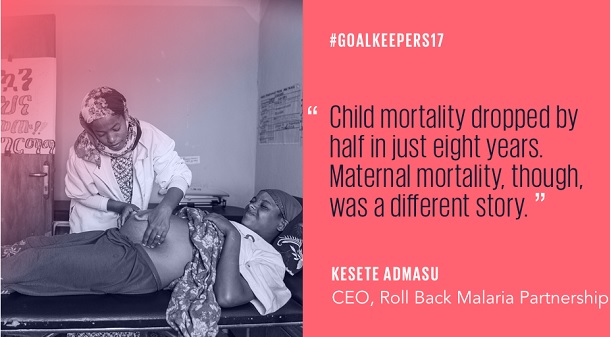
The fact that maternal mortality rate has been cut in half in the past generation is one of the more important successes in global health
By Bill and Melinda Gates Foundation (Global Goals) |
If you were trying to invent the most efficient way to devastate communities and put children in danger, you would invent maternal mortality.
So the fact that the number of mothers who die has been cut in half in the past generation is one of the more important successes in global health. It’s all the more impressive because reducing maternal mortality is really hard.
Statistically speaking, it’s rare compared to, say, child mortality. That’s why maternal deaths are rendered per 100,000 live births instead of per 1,000. Therefore, for every new solution that saves a mother’s life, you need to deliver 100 times as much of that solution to have the same impact.
Luckily, solutions already exist. To deliver those solutions to all women, the most important priority is persuading them to give birth in health facilities, where they can get skilled obstetric care, instead of at home. We asked Kesete Admasu, former minister of health of Ethiopia, to write about how his country created a health infrastructure that helped women make this decision.
As Dr. Kesete suggests, as this shift from home to facility births continues, the maternal health community must make sure that the obstetric care provided in facilities is of the highest quality. With many more mothers delivering at facilities, it puts new pressures on health systems—they need more equipment, more staff, and more training. With these resources, developing countries will continue to drive down maternal mortality at the accelerated rates of the past 25 years.
GRAPH: Maternal Deaths Per 100,000 Live Births In Ethiopia
Kesete Admasu
CEO, Roll Back Malaria Partnership (former minister of health, Ethiopia, 2012–2016)
When I joined the Ethiopian Ministry of Health in 2002, we were using a health system designed for other countries.
Our tiny number of highly trained health providers concentrated in big cities, far away from the 85 percent of our people who live in rural areas. This mismatch led to some of the worst child and maternal mortality statistics in the world.
We were committed to saving those lives, but it didn’t make sense to put good money into a bad system. So we built a new one. Launched in 2003, the Health Extension Program gives Ethiopians the services they need, where they need them. We trained 40,000 health extension workers to provide basic information and care to all 100 million Ethiopians. The goal was to put knowledge and power—and, ultimately, responsibility—in the hands of local people.
Read the complete story at Global Goals
——
See also:
- Strong Coffee, Stronger Women
- Ethiopian National Public Health Training Center Officially Inaugurated
- Men in rural Ethiopia show that family planning is not just a women’s issue
- Reach for Change and IKEA Foundation: New Partnership to Impact 84,000 Children in Ethiopia
- New EU Funding Will Provide Essential Nutrition Treatment for 130,000 Children under the Age of Five in Ethiopia
